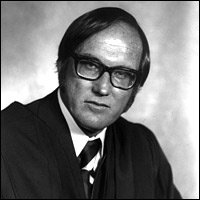 Prominent cases during those terms include Roe v. Wade (1973), protecting abortion rights; Branzburg v. Hayes, (1972), invalidating the use of the First Amendment as a defense for reporters summoned to testify before a grand jury; and Furman v. Georgia, 408 U.S. 238 (1972), a death penalty case that led to a moratorium on the use of the death penalty. The pre-Court papers include Rehnquist's Stanford Law School notebooks from 1951-1952 and a journal with entries dating from 1947-1948 and 1965.
Prominent cases during those terms include Roe v. Wade (1973), protecting abortion rights; Branzburg v. Hayes, (1972), invalidating the use of the First Amendment as a defense for reporters summoned to testify before a grand jury; and Furman v. Georgia, 408 U.S. 238 (1972), a death penalty case that led to a moratorium on the use of the death penalty. The pre-Court papers include Rehnquist's Stanford Law School notebooks from 1951-1952 and a journal with entries dating from 1947-1948 and 1965.Rehnquist's personal correspondence will be released by January 5, 2009. The library reports that "additional materials including speeches, writings, book drafts, and other documents will be opened in the spring of 2009." Remaining Supreme Court files "shall remain closed during the lifetime of any member of the Supreme Court who served with William H. Rehnquist."
The 37-page finding aid is available on-line. The announcement is here. A New York Times article describes the collection, finding the case materials to "contain mostly un-illuminating draft opinions and perfunctory communications between the justices," with occasional files, including Laird v. Tatum, containing more interesting material. This is consistent with other collections, such as Thurgood Marshall's papers. According to the New York Times, the Roe v. Wade file contains "newspaper and magazine clippings, some of them critical, as well as disturbing color photographs of aborted fetuses."
NOTE TO RESEARCHERS: I have done research at the Hoover Institution archives. The archives staff is very professional and helpful, and you are likely to find a level of professionalism that parallels the Library of Congress manuscript reading room and the presidential libraries. Most of the Hoover Institution's rules for researchers are the ones you encounter in most archives. The one significant difference, which will pose difficulties for many researchers, is the unusually stringent limits on the number of copies you can make: 100 photocopies in a year. Special permission is required for the use of scanners or cameras, and only a maximum of ten images may be taken. It is possible to get permission to make more copies -- but not a lot more. Researchers with limited time to spend at the library, and used to short trips during which relevant documents are copied, are going to have trouble.
There is a reason for this limitation. I was told that the library has had difficulties with a researcher publishing archival materials without permission. Legitimate concerns about protecting unpublished manuscripts in other collections are, unfortunately, applied to routine archival sources that can be photocopied at other archives.
The limitation on photocopying is particularly problematic for writers of law review articles, since law reviews usually require that you supply them with copies of archival documents cited. And any researcher with limited time to spend at the library is going to have trouble. This means that once more papers are released, the most extensive research in these papers is likely to be done by Stanford-area researchers, and by researchers with the budget and lack of family, teaching, and other responsibilities to enable them to spend long stretches in Palo Alto transcribing archival materials by hand.
This collection is likely to be widely used. Let's hope the Hoover Institution will reconsider such a stringent across-the-board photocopying policy. Absent that, full use of the records will be stymied, and the library's small reading room will be cramped with researchers who happen to have the time to type up copies of documents.